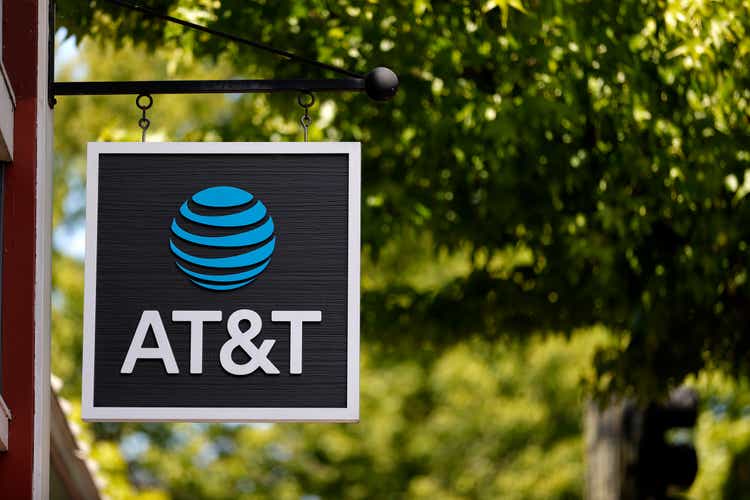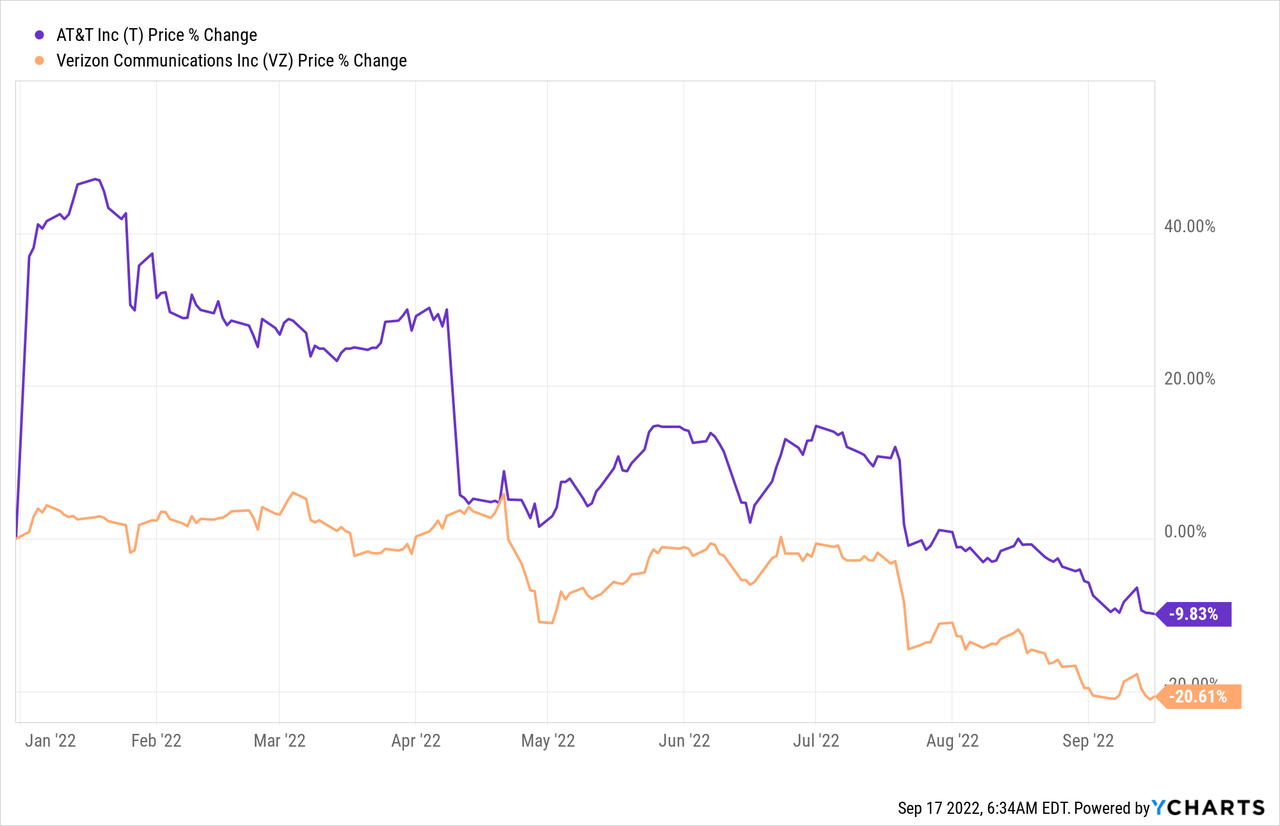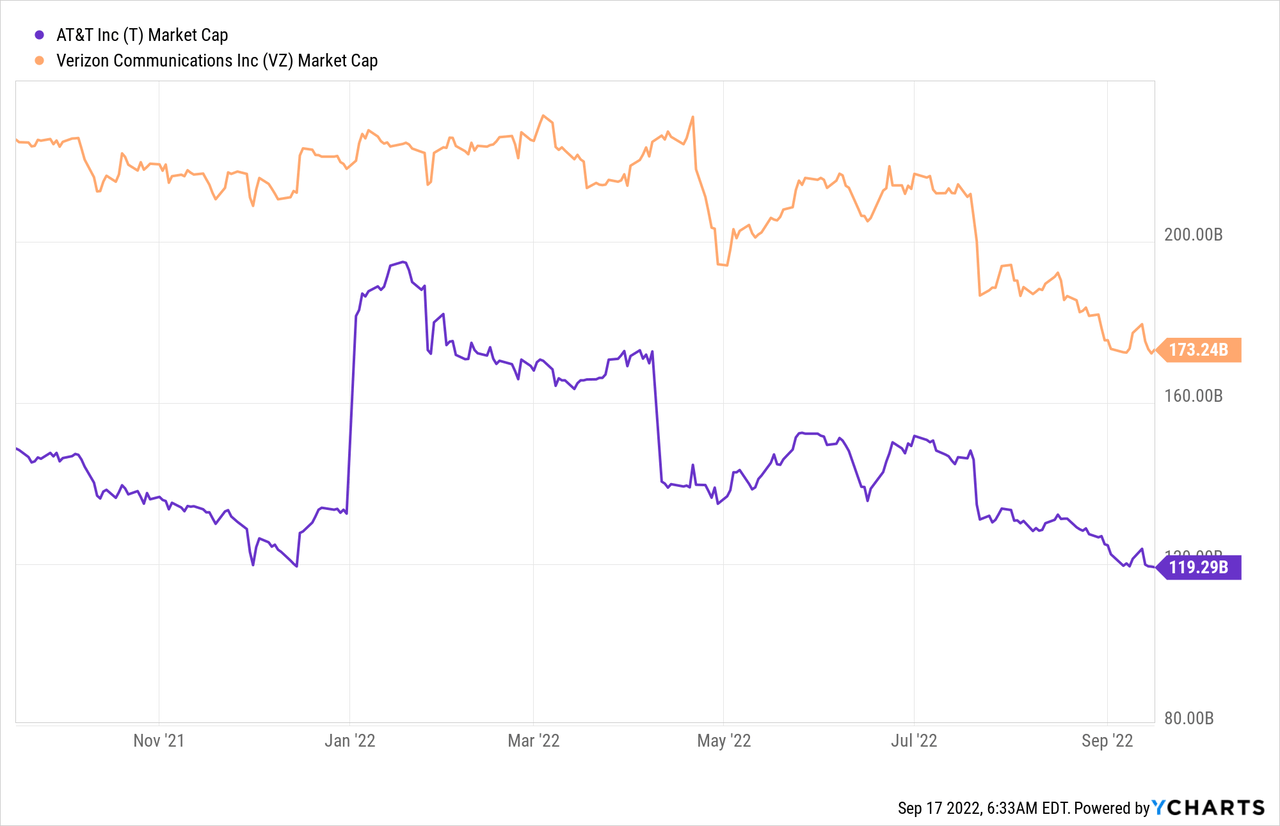
Justin Sullivan
AT&T (NYSE:T) and Verizon (VZ) are not only competing for customers in their operating segments, but they are also competing for investors who obviously have the choice to buy either one of the companies’ shares. AT&T and Verizon both pay shareholders attractive dividends and distribute a significant portion of their free cash flow annually. However, with AT&T recently lowering its free cash flow outlook by $2.0B and separating itself from its content business, I believe it is a good idea to compare the telecommunications firm to Verizon and see which company offers shareholders the better deal. I believe both companies are attractive for dividend investors, but one company has an advantage over the other!

AT&T vs. Verizon: which is the better dividend stock for investors?
Weak top line growth
A stock’s dividend is obviously just one factor that matters to investors. Other factors such as valuation, free cash flow payout ratio and the safety of the dividend also matter and must be taken into account before deciding which dividend stock offers the best potential.
The first point I would like to make relates to prospects for top line growth for both AT&T and Verizon. Both telecoms face saturated market conditions in their core businesses, but they do see some momentum in their broadband segments. AT&T had 316 thousand net-adds in its fiber business in Q2’22 while Verizon had 268 thousand broadband net-adds in the second-quarter. While the broadband business shows some promise for both companies due to accelerating customer adoption, both AT&T and Verizon won’t see a whole lot of top line growth going forward. AT&T is projected to see a 2% revenue drop next year while Verizon is only expected to see a 1% revenue increase year over year.
Free cash flow potential and payout ratio
AT&T cut its free cash flow (“FCF”) guidance from $16B to $14B as customers are increasingly under pressure from high inflation and delay paying their bills. AT&T’s free cash flow in Q2’22 was $1.4B which was not sufficient to pay its quarterly dividend bill which runs at approximately $2.0B. Based on AT&T’s current free cash flow outlook for FY 2022, the telecom has an expected FCF payout ratio of 57% in FY 2022… assuming there is no change to the dividend or the FCF forecast in Q3 or Q4.
Verizon has not given a free cash flow forecast for FY 2022, but I recently estimated that the telecom could achieve $17-19B in free cash flow this year. In Q2’22, Verizon’s free cash flow was $6.2B which covered the dividend payment of $2.7B easily. Based off of a low-case estimate of $17B in free cash flow in FY 2022 and assuming no change in the dividend rate, Verizon is set to pay out 63% of its estimated free cash flow this year. AT&T is therefore faring slightly better than Verizon regarding free cash flow payout.
FCF valuation
Based off of $14B in free cash flow for AT&T and $18B (midpoint) in free cash flow for Verizon, AT&T has a P-FCF ratio of 8.5 X while Verizon has a P-FCF ratio of 9.6 X.

Earnings valuation
AT&T and Verizon are both attractively valued based off of free cash flow, but the former has a slight advantage. Both stocks are also cheap based off of earnings, with AT&T having a slight advantage as well.
AT&T is expected to generate EPS of $2.52 in FY 2023 while Verizon is expected to have an EPS of $5.28 in that same year. The drop in AT&T’s EPS this year is related to the spin-off of Warner Bros. Based off of forward earnings, AT&T has a slightly lower P-E ratio (6.6 X) than Verizon (7.8 X).
|
AT&T |
FY 2022 |
FY 2023 |
FY 2024 |
Verizon |
FY 2022 |
FY 2023 |
FY 2024 |
|
EPS |
$2.54 |
$2.52 |
$2.58 |
EPS |
$5.18 |
$5.28 |
$5.38 |
|
YoY Growth |
-25.39% |
-0.66% |
2.46% |
YoY Growth |
-3.94% |
1.93% |
1.94% |
|
P-E Ratio |
6.60 X |
6.64 X |
6.48 X |
P-E Ratio |
7.97 X |
7.82 X |
7.67 X |
(Source: Author)
Yield comparison
AT&T has an annual dividend payout of $1.11 per-share after separating itself from Warner Bros. Media while Verizon pays $2.61 per share. Verizon raised its payout by about 2% in the third-quarter. Taking into consideration current market prices for both telecom’s, AT&T’s dividend yield is 6.6% while Verizon’s yield is 6.3%. Again, AT&T has a slight advantage here.
Risks with AT&T, Verizon
Since it is taking customers longer to pay their bills, AT&T had to adjust its free cash flow forecasts by $2.0B. With consumer prices continuing to soar in recent months, many more of AT&T’s (and Verizon’s) customers may be put into a position in which they are struggling to pay their phone bills on time. For both companies this means that free cash flow risks have gradually increased in FY 2022. A deterioration in the health of the American consumer could lead to lower free cash flows and dividend payments for both telecoms.
Final thoughts
Despite growing free cash flow risks and a lowered FCF outlook for FY 2022, AT&T looks to be the better choice than Verizon here: AT&T’s estimated free cash flow this year should easily cover the firm’s dividend. I believe that AT&T is also the better deal regarding valuation since AT&T’s shares are trading at lower P-E and P-FCF ratios than Verizon. Although I own both stocks, the winner right now seems clear: AT&T is the better and safer dividend pick!


Be the first to comment